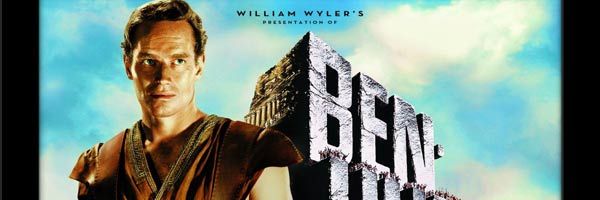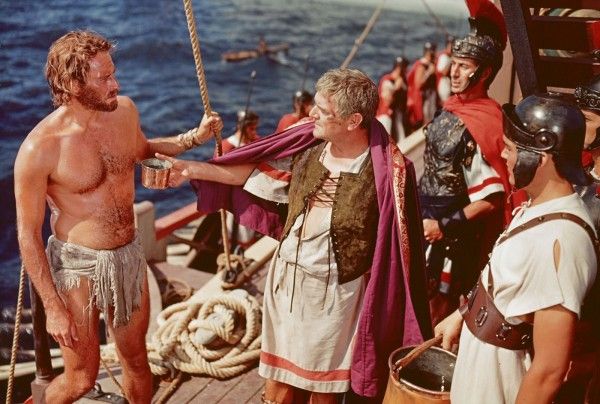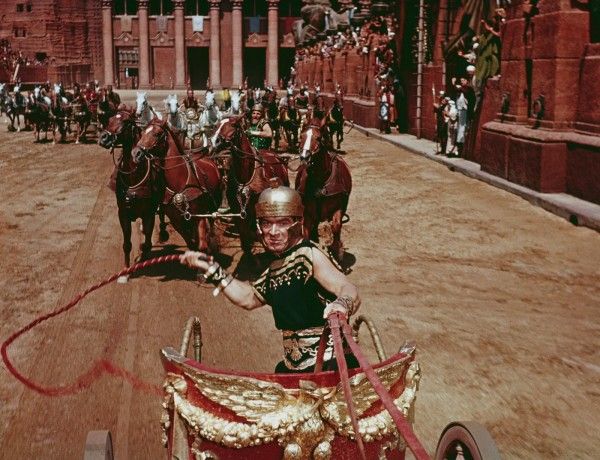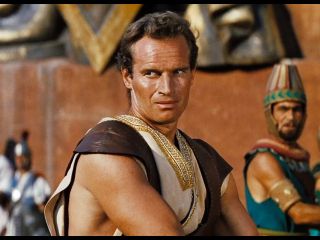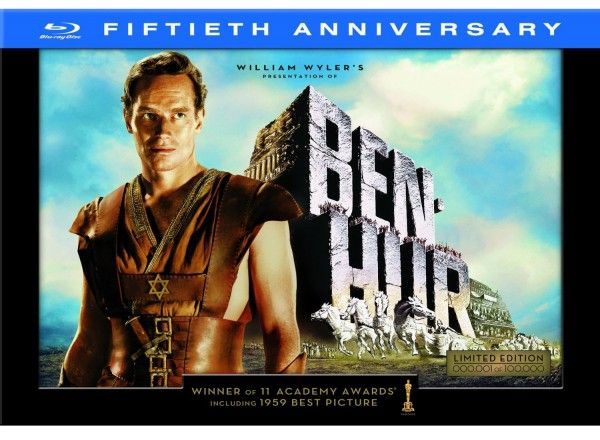Ben-Hur is the biggest of the big, the mightiest of the mighty, the most epic of the epic. Released in 1959, Ben-Hur was the event film of its day and sold 111 Million tickets, which makes it the fifth most successful movie of all time when prices are adjusted for inflation. The story of Judah Ben-Hur (Charleton Heston) and his journey to defeat his old best friend Messala (Stephen Boyd) - and meeting Christ along the way - is a long movie that is celebrated for its chariot race, justly revered as one of the great pieces of stunt filmmaking. The Blu-ray celebrates Ben-Hur’s fiftieth anniversary, and our review follows after the jump.
First off, if the film came out in 1959, you add fifty and you get 2009. Don’t get the Fiftieth thing at all. Whatever, it’s a marketing tool, I guess.
Charlton Heston stars as Judah Ben-Hur, a Jewish prince who returns home and meets his best friend Massala (Boyd), who now commands the Roman legions. Their friendship can’t stand the strain of Massala’s request to inform on his fellow Jews, and when an accident injures the local governor it allows Massala to send Judah’s family to prison and put JBH into slavery. There he‘s put in the galleys for the Roman fleet, and rows for Quintus Arrius (Jack Hawkins). When their ship is attacked, Judah saves Quintus’s life and for that is rewarded with Princedom yet again. He meets Sheik Ilderim (Huhg Griffith) and is asked to ride his horses in the big chariot race. Judah agrees because it would allow him to go up against Massala.
Jesus Christ also shows up, first offering Judah water when he needs it most, then later is tried and crucified. Judah – of course – becomes a convert. His mother and sister have suffered in jail and gone to leprosy, which is hidden from Judah and gives him greater motivation to beat his former friend.
Though nearly four hours in length, the story of Ben-Hur is relatively simple, and that’s part of the appeal. Uncredited writer Gore Vidal has famously talked about how he fixed the screenplay by making the conflict between the two men that of ex-lovers. That can be read into the film, but it plays regardless of that reading. Old friends turned enemies is a good enough device for an action film.
Director William Wyler has no sense of camp, which is both good and bad for the film. It doesn’t have the gaudy touches or sarcastic knowing performances of Cecil B. DeMille’s The Ten Commandments, which can make it a bit dry in spots. But the action sequences are so spectacular that you don’t necessarily need it. Wyler’s command of the widescreen format is also strong, and this is one of those films where the boats that fight look real, and the hundreds and thousands of extras are there, and it’s evident that this has a scale that is unmatched. And that reality is worth so much – especially nowadays where that many people are all done via computer.
The film is structured so the first half is two hours and twenty minutes before the intermission, but it’s all building to that Chariot race. The first half also moves well as it lines up all the conflict and gets Judah in and out of slavery. But you know that the race is coming, so it builds anticipation. Then the second half is much shorter, which then makes the second half really pop. The second half starts all about the race, and then it comes up and it delivers.
Perhaps some will be less impressed with watching twenty horses walk in a circle in perfect synchronization, but you can tell that it took months of training and shooting to get that right. Then comes the race – which was shot by Yakima Canutt, the world’s greatest second unit director. Heston was doubled by Canutt’s son, but the trickeries are kept minimal and you buy everything that’s going on in the race because most of the stunts are real - though there seem to be some dummies, and the occasional use of rear screen projection. It’s a great piece of action that has a dramatic build as the other racers crash out violently. I recently watched the Star Wars complete saga blu-rays, and it’s apparent that George Lucas was paying homage to this in The Phantom Menace with the Pod Race. But his work there speaks to the limitations of CGI. Though the conclusion here is obvious, there are real nail-biting moments of destruction and speed. When you have a bunch of CGI characters in CGI environments whipping around like that, there’s simply no comparison. Practical wins every day of the week.
The film was sold partly for its religious elements, but what’s nice about the film (though it serves as the backbone to the conclusion), those parts never overpower the story. Judah Ben-Hur prays for forgiveness for wanting to race his old best friend, but race he does, and the elements of the film that are indelible have little to do with the old time religion. Ironically, the films of these sorts that have aged the best (this, El Cid and Spartacus) are the ones that keep religion in the margins or mostly removed. Mostly because those other films don’t know how to make that story dramatically viable (see: The Bible or The Greatest Story Ever Told). And though Wyler avoids camp, he understands character and spectacle. Though it’s hard to call Ben-Hur one of the greatest films of all time, it definitely delivers a scale that is unmatched in cinema history, and is well worth checking out.
Ben-Hur is presented in widescreen (2.76:1) and in DTS-HD 5.1 Master audio. The biggest problems with films this old is that the audio – when remixed for surround often sounds a little warped, as dialogue snippets sometimes come into greater volume the longer they go. That’s a mild problem here, but the picture quality is excellent as the film recently went through a remastering, and the color and sharpness is brilliant (the film was shot in 65 mm). The transfer of the film is amazing – there’s no two ways about it, it hasn’t looked this good since the first prints were shown. The film also comes with a commentary by T. Gene Hacker, with additional comments from Heston. This was recorded years ago for the film’s first DVD release and Heston is lucid, but he cannot possibly fill the 222 minute running time by himself, so Hacker’s comments are welcome and give a greater perspective to the project. There is also a music only track, which is welcome as the score (by Miklos Rosa) is one of the greatest parts of the film. On the first disc are also five trailers for the film’s release.
Disc three houses the rest of the video supplements. It starts with “Charlton Heston and Ben-Hur: A Personal Journey” (78 min.) that walks through the early years of Heston’s life and marriage spends the majority talking about the shooting of Ben-Hur, then covers the rest of his life in a much shorter section. Fraser Heston and Joe Canutt are two of the main interviewees, with Tom Selleck and Julian Glover also appearing (among others). It’s followed by “Ben-Hur: The Epic That Changed Cinema” (58 min.) which gets people like George Lucas, Ben Burtt, Ridley Scott and Ernest Dickerson to talk about the film and its influence, while “Ben Hur: The Making of an Epic” (58 min.) gets into the more practical elements of the film’s creation, and talks about the casting process (Paul Newman was considered) and the lengths Wyler went through to get the film right. “Ben Hur: A Journey Through Pictures” (5 min.) is a scored still gallery. The 1923 version of Ben-Hur is also included, and it’s restored, and color tinted as it was originally projected. The 1959 remake in this case is much better. There are also four Screen tests that offer looks at Leslie Nielsen. Cesare Danova, Yale Wexler, George Baker, William Russell, and Haya Harareet in footage with and without sound (29 min.). There’s six newsreel clips on the film (10 min.). Rounding out the set are highlights from the 1960 academy awards ceremony (10 min.) where the film won its eleven Oscars.
The deluxe package also comes with a book that is picture heavy and gives a brief look at the film and its makers, but more interesting is the replica of Heston’s journal from the making of the picture. Each day includes his schedule and what he thought of the day’s events. It also comes with pictures, and nice details. It’s a quick read, but fascinating.

